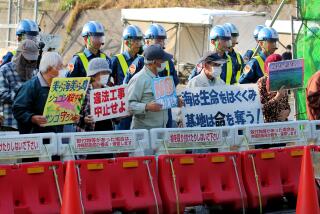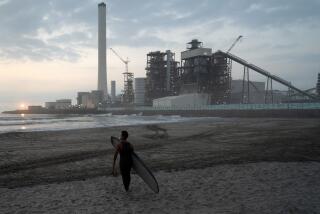Japan labors to cool reactors: Workers, power source added
Authorities battling the nuclear disaster at the Fukushima Daiichi power plant have doubled the number of workers on the site to 100 in an effort to continue cooling the three reactors and the spent fuel pools but have abandoned — at least temporarily — plans to use helicopters to dump water on the pools because of the radiation danger. Police may now use water cannons to spray the pools.
FOR THE RECORD:
Atomic agency official: An earlier version of the article incorrectly spelled the first name of Yukia Amano, chief of the International Atomic Energy Agency, as Yukio.
Workmen are also nearly finished stringing a new power line from the electrical grid to the power plant, which could ease the situation somewhat by providing a stable source of power for valves and controls at the plant and for pumps supplying water to the spent fuel pools.
It is too late for the electricity to do much good for the three endangered reactors, however, because their cooling systems all appear to have been damaged by the hydrogen explosions that have wracked the plants. Only external pumps can now be used for those reactors.
Photos: Scenes of earthquake destruction
The status of reactor No. 3 at the site was not clear, with some reports saying that the reactor containment vessel may have been breached and was releasing radioactivity and others saying that it was still intact.
Authorities had feared a breach of the reactor vessel after the eruption of a plume of smoke from the reactor on Wednesday. The most recent statement from Chief Cabinet Secretary Yukio Edano, however, indicated that the smoke was probably steam from a spent fuel pool at that reactor building and that the reactor vessel itself had not been breached.
Officials are particularly concerned about reactor No. 3 because it is the only reactor at the facility that is fueled with what is known as a mixed oxide fuel. The pellets in mixed oxide fuel contain both plutonium and uranium. Plutonium is highly carcinogenic in small quantities, and its release into the environment would be very dangerous.
The containment vessel at reactor No. 2 has previously been breached, and it appeared to be leaking small amounts of radioactivity.
As the crisis at the power plant entered its sixth night, the situation appeared to be deteriorating. One sign was that the Japanese government increased the maximum radiation dose that workers could be exposed to from 100 millisieverts to 250 millisieverts, describing the move as “unavoidable due to the circumstances.”
The workers are all wearing full protective gear and working only in short shifts, but it is believed they are still being exposed to significant doses of radiation.
All of the workers were pulled out of the plant for nearly an hour Wednesday when radiation levels spiked, but pumps continued to inject seawater into the reactors in their absence, according to Tokyo Electric Power Co., which owns the plant. The workers returned as soon as the radiation levels had subsided. The radiation spike was believed to result from the release of steam from reactor No. 2.
Authorities estimated that about 70% of the fuel rods in reactor No. 1 had been damaged and about 30% of the rods in reactor No. 2. Those were merely estimates, however, because they have no direct way to measure the extent of damage.
Military helicopters were seen flying over the reactor buildings Wednesday night to measure radiation levels. Authorities had planned to use helicopters to drop water on the spent-fuel cooling ponds on the roofs of the buildings, which also have lost their emergency cooling systems.
The need was especially critical at the pool for reactor No. 4, which has caught fire twice and where the cooling water was boiling and believed to be reaching dangerously low levels. Authorities concluded, however, that radiation levels were too high to allow the water drops.
That spent fuel pool contains about 135 tons of uranium fuel rods, according to Marvin Resnikoff, a nuclear physicist who studies disposal of spent fuel. Some reports suggest that the spent fuel in that pool has now boiled off all the cooling water and the fuel rods are exposed to the air and heating up. That has not been confirmed.
Resnikoff also noted that, in addition to the spent fuel pools on the roofs of each reactor, there is a larger stand-alone fuel pool at ground level. “We are not certain what happened to this in the tsunami,” he said.
Authorities said the police may now attempt to use water cannons, normally used to quell riots, to spray water into the pools. Workers will first have to remove some debris from near the buildings so the apparatus can get close enough.
As a further indication of the seriousness of the problem, the United Nations nuclear agency will call an emergency meeting to discuss the problem. Yukia Amano, chief of the International Atomic Energy Agency, is flying to Japan on Wednesday to consult with Japanese authorities about the crisis.
U.S. military authorities on Wednesday night (Japanese time) warned all military not to go within 50 miles of the stricken plant without special authorization. The U.S. Embassy in Tokyo also cautioned all U.S. citizens to observe the same restriction.
The good news is that the reactors should be undergoing a certain amount of cooling on their own. When an operating reactor is shut down, it continues to produce a large amount of heat, known as decay heat. Within the first week after a shutdown, that decay heat declines by about 50%, experts said, so that the reactors require less external cooling.
Photos: Scenes of earthquake destruction






